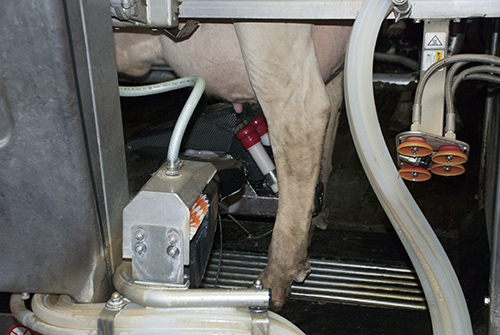
Chad Kieffer is a dairy nutritionist and part owner of his family's dairy farm, Kiefland Holsteins, in Utica, Minn. Four years ago, the farm replaced their outdated parlor with the installation of three robotic milkers; two years later, they added two more. Kieffer shared lessons his family learned since the installation of their automated milking system at the Precision Dairy Conference in Rochester, Minn.
Their herd has adjusted very well to their new milking program, boasting a rolling herd average of 29,000 pounds of milk per cow. While there may be a stigma that robot herds are not high producing, Kieffer feels otherwise. "Multiple herds are over 100 pounds of milk per cow per day with robots," he said. "It can be done successfully."
The farm also utilizes a robotic feed pusher, which Kieffer says is low maintenance and saves energy. "It has also proven successful in improving feed intake," he said.
As for footbaths, Kieffer has found it best to put them in crossovers than rather in return lanes.
Kieffer offered these other keys to robot success:
- Maximize milkings per hour and milkings per day, while minimizing robot downtime.
- Remove slow and inefficient cows, including those that are slow milking or perpetual "fetch" cows.
- Minimize robot failures. On their farm, they aim for less than five per robot per day.
- Reduce milking preparation time by keeping cows clean and singing udders.
- Optimize milking time by assuring all mechanical aspects of the robots are working.
- Start with the right barn layout for smooth cow movement.
- Have a passion for cows or have employees that do.
- Identify the best fit ration, and work with a knowledgeable team to help get you there.
- Maintain open communication among owners and employees, and strong management skills of both cows and people.
- Learn how to do maintenance repairs on your own, and build a strong relationship with your dealer for technical support.

The author is an associate editor and covers animal health, dairy housing and equipment, and nutrient management. She grew up on a dairy farm near Plymouth, Wis., and previously served as a University of Wisconsin agricultural extension agent. She received a master's degree from North Carolina State University and a bachelor's from University of Wisconsin-Madison.








